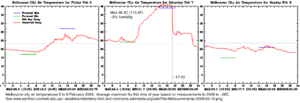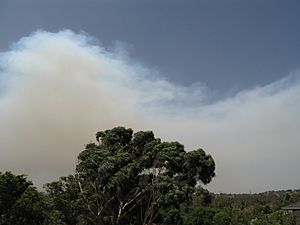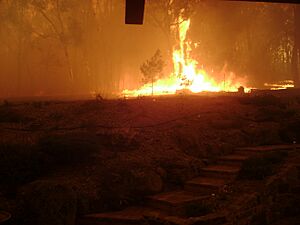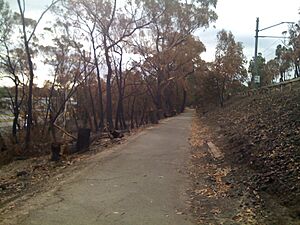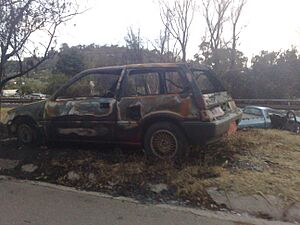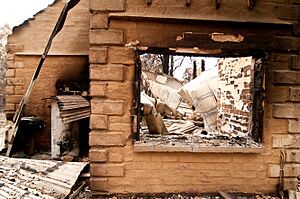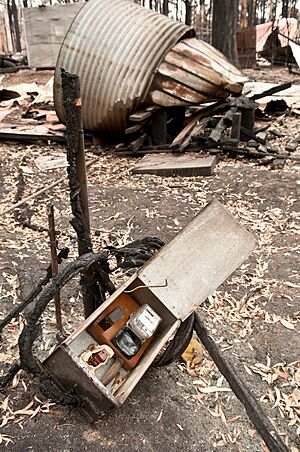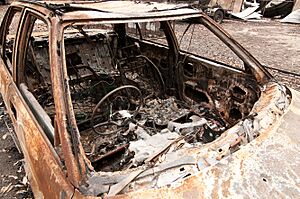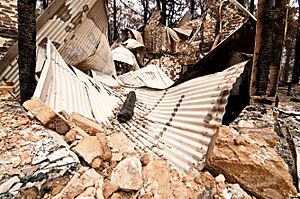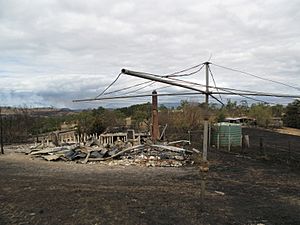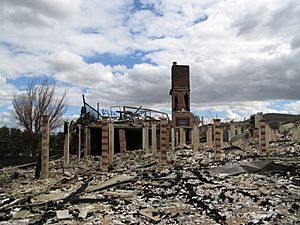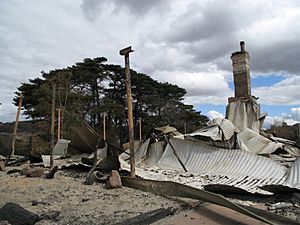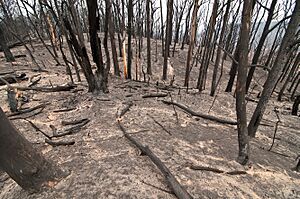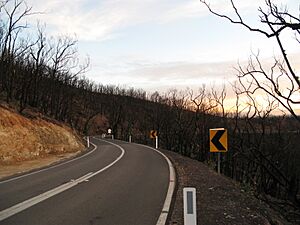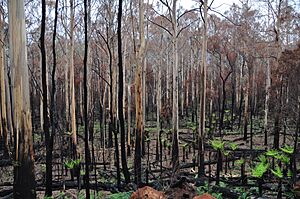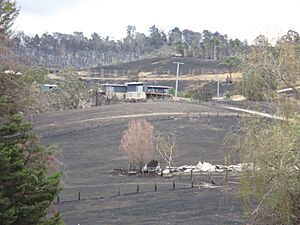Black Saturday bushfires facts for kids
Quick facts for kids Black Saturday Bushfires |
|
|---|---|

MODIS Aqua satellite image of smoke plumes and a pyrocumulus cloud northeast of Melbourne during the morning of 7 February 2009.
|
|
| Location | Victoria, Australia |
| Statistics | |
| Date(s) | 7 February – 14 March 2009 |
| Burned area | 450,000 hectares (1,100,000 acres) |
| Cause | Various confirmed sources including: |
| Land use | Urban/Rural Fringe Areas, Farmland, and Forest Reserves/National Parks |
| Buildings destroyed | 3,500+ (2,029 houses) |
| Deaths | 173 |
| Non-fatal injuries | 414 |
The Black Saturday bushfires were a series of very serious bushfires that started or were already burning across the Australian state of Victoria. This happened on and around Saturday, 7 February 2009. It was one of Australia's worst bushfire disasters ever.
These fires happened during extremely dangerous weather conditions for bushfires. Sadly, 173 people died, making it Australia's highest-ever loss of life from a bushfire. Many people also lost their homes and family members.
On Saturday, 7 February, about 400 separate fires were recorded. This day is now widely known in Australia as Black Saturday.
Australia's Deputy Prime Minister, Julia Gillard, called Black Saturday "a tragedy beyond belief." She said it was "one of the darkest days in Australia’s peacetime history."
A special investigation, called the 2009 Victorian Bushfires Royal Commission, was held to find out what happened and how to prevent future disasters.
Contents
What Caused the Fires?

A week before the fires, a big heatwave hit southeastern Australia. From January 28 to 30, Melbourne had three days in a row where temperatures were above 43°C (109°F). On January 30, the temperature reached 45.1°C (113.2°F), which was the third hottest day in the city's history.
This heatwave was caused by a slow-moving high-pressure system over the Tasman Sea. Hot, tropical air was pushed down over southeastern Australia.
On February 7, the day the fires started, several places in Victoria, including Melbourne, recorded their highest temperatures ever. The day before, fire chiefs warned that conditions were "almost uncharted territory." The Premier of Victoria, John Brumby, also warned that it would be the "worst day [of fire conditions] in the history of the state."
Black Saturday: The Day of the Fires
On Friday evening, February 6, 358 firefighters were ready for the extreme conditions expected. By Saturday morning, hot winds blowing over 100 km/h (62 mph) hit the state. Temperatures were very high, and the air was extremely dry. A total fire ban was put in place for all of Victoria.
As the day went on, Melbourne reached its hottest temperature ever recorded: 46.4°C (115.5°F). Humidity levels dropped to just two percent, meaning the air was incredibly dry. The fire danger levels were higher than ever before, even worse than the famous "Black Friday" fires in 1939 and the "Ash Wednesday" fires in 1983.
Around midday, strong winds caused a power line to fall at Kilmore East. This sparked a bushfire that became the deadliest and most intense firestorm Australia had ever seen. Most of the fire activity happened between the afternoon of February 7 and 7:00 pm, when winds and temperatures were at their highest.
Key Events of the Fires

Here are some of the main events that happened during the Black Saturday bushfires:
- January 28, 2009: The Delburn fire started in Central Gippsland. It was thought to be caused by arson (someone deliberately starting it).
- February 4: The Bunyip State Park fire began.
- February 7 (Black Saturday):
* 5:00 am: The Bunyip State Park fire broke through its boundaries. * Late morning: Many new fires started as temperatures and winds increased. * 11:50 am: Power lines fell at Kilmore East, starting a fire that became the deadliest. Winds of 125 km/h (78 mph) fanned this fire, making it grow very quickly. * 12:30 pm: The Horsham fire started. * 3:04 pm: Melbourne reached its peak temperature of 46.4°C (115.5°F). * 4:20 pm: The Kilmore East fire reached Strathewen. * 4:45 pm: The Kilmore East fire reached Kinglake. * 5:00 pm: The wind direction changed in Melbourne, blowing from the southwest. * 5:10 pm: Melbourne's temperature dropped quickly from over 45°C (113°F) to about 30°C (86°F) in just 15 minutes. * 5:30 pm: The wind change reached the Kilmore East and Murrindindi Mill fire fronts. * 6:00 pm: The Beechworth fire started. * 6:45 pm: The Murrindindi Mill fire reached Marysville. * 10:00 pm: Police announced an early estimate of 14 deaths.
- February 8: The Kilmore East and Murrindindi Mill fires joined together to form the huge Kinglake fire complex.
- February 10: More fires joined to form the Maroondah/Yarra complex.
- February 19: The estimated number of deaths increased to 208.
- February 23: Hot, windy conditions caused many fires to flare up again, and new ones started.
- March 4: Cooler weather and rain helped firefighters control and contain several fires.
- Mid-March: Good weather helped put out many of the remaining fires.
Major Fire Areas
Kinglake–Marysville Fires
The Kinglake fire complex was formed when two earlier fires, the Kilmore East fire and the Murrindindi Mill fire, joined together. This happened after the wind changed on the evening of February 7. This complex was the largest of the fires on Black Saturday. It burned over 330,000 hectares (815,450 acres). It was also the most destructive, destroying over 1,800 houses and causing 159 deaths in the region.
Kinglake Area (Kilmore East Fire)
Just before midday on February 7, strong winds knocked down a 2 km (1.2 mi) section of power lines in Kilmore East. This started a fire around 11:45 am in open grasslands next to pine tree farms. The fire was pushed by extreme winds and traveled 50 km (31 mi) southeast. It moved through towns like Wandong and Clonbinane, into Kinglake National Park, and then to towns like Humevale, Kinglake West, Strathewen and St Andrews.
When the cool wind change arrived around 5:30 pm, it brought strong southwesterly winds. This wind change turned the long, narrow fire into a wide fire front. It then moved northeast through Kinglake, Steels Creek, and other towns.
This area was the worst hit in Victoria. A total of 120 people died, and more than 1,200 homes were destroyed. The investigation found that an old power line was the cause of the Kilmore East-Kinglake bushfire.
Marysville Area (Murrindindi Mill Fire)
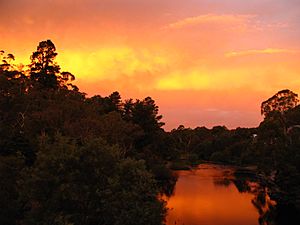
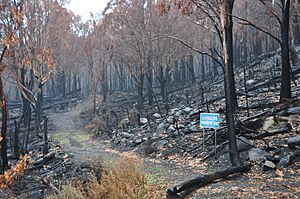
The Murrindindi Mill fire started around 2:55 pm. It burned southeast towards Narbethong. Firefighters reported flames as high as 100 meters (328 feet). At Narbethong, 95 percent of the town's houses were destroyed. When the southerly wind change hit, the fire swept towards the town of Marysville.
Many Marysville residents thought the fire would miss their town. But around 5:30 pm, the wind changed direction and brought the fire directly into the valley.
A police officer later said that Marysville's main street was destroyed. Only a few buildings survived. Reports estimated that around 100 of the town's 500 residents might have died. Premier Brumby described the scene: "There's no activity, there's no people, there's no buildings, there's no birds, there's no animals, everything's just gone."
Eventually, 34 deaths were confirmed in the Marysville area. Almost all of its 400 buildings were destroyed. Other nearby towns like Buxton and Taggerty were also badly affected.
Investigators first thought this fire was caused by arson. However, later investigations in 2011 found that arson was not responsible.
Beechworth Fire
In Beechworth, a fire burned over 30,000 hectares (74,130 acres). It threatened towns like Yackandandah and Stanley. This fire started from a fallen power line around 6:00 pm on February 7. It was pushed south by hot winds through pine tree farms.
The fire destroyed many buildings in Mudgegonga, southeast of Beechworth, and two residents died. Thick smoke made it hard to see the fire from the air.
By February 10, firefighters had created a 115 km (71 mi) containment line around the Beechworth fire. They worked to build more lines, but the fire continued to burn.
Bendigo Fire

A fire west of the city of Bendigo burned about 500 hectares (1,235 acres). It started around 4:30 pm on February 7 and moved through Long Gully and Eaglehawk. It came within 2 km (1.2 mi) of central Bendigo before being controlled. This fire destroyed about 61 houses in Bendigo's western suburbs. One person, who was ill and couldn't leave his house, died in the fire.
Police investigated whether this fire was caused by arson. On June 10, 2009, police announced they were sure the fire was started on purpose. In February 2010, two teenagers were arrested and charged in connection with the Bendigo fires. However, in November 2011, a court found that the youths were not able to stand trial due to intellectual disabilities.
Bunyip State Park Fire
A fire started at Bunyip Ridge in the Bunyip State Park on February 4. It was thought to be deliberately lit. By February 6, the fire had burned 123 hectares (304 acres). Firefighters worried it would escape the park on February 7 due to extreme weather.
On the morning of February 7, the fire broke through its boundaries. It moved much faster than expected. Firefighters had to retreat because the conditions were too dangerous. The fire left the park around 4:00 pm and by 6:00 pm had burned 2,400 hectares (5,930 acres) of forest and farmland. It threatened towns like Labertouche and Drouin.
The fire destroyed about a dozen houses in Labertouche, Tonimbuk, and Drouin West. By the afternoon of February 9, the fire's progress had stopped, but it had burned through 24,500 hectares (60,540 acres).
Central Gippsland Fires
The Central Gippsland bushfires began in a pine tree farm near Churchill around 1:30 pm on February 7. It quickly spread southeast. By late afternoon, the fire was approaching Yarram and Woodside on the south Gippsland coast. When the cool wind change came around 6:00 pm, it pushed the fire northeast through Callignee, destroying 57 of its 61 homes.
The fire also threatened the Loy Yang Power Station. It came close to the coal mine but did not damage any important equipment.
By February 9, the Churchill fire complex was still burning. It had burned over 32,860 hectares (81,199 acres) and killed eleven people. Investigators believed arson was the cause of the Churchill fire. A man was arrested and later convicted of 10 counts of arson causing death in April 2012.
Dandenong Ranges Fire
In Upper Ferntree Gully, a fire damaged the railway track and closed the Belgrave railway line. This fire was quickly put out by firefighters.
In the southern Dandenong Ranges, bushfires started around Narre Warren. One was caused by sparks from a power tool. Six homes were destroyed in Narre Warren South and three in Narre Warren North.
Wilsons Promontory Fire
On February 8, lightning started a fire in Wilsons Promontory that burned over 11,000 hectares (27,180 acres). This fire didn't immediately threaten campers, but authorities decided to evacuate the park because of the large amount of dry fuel and difficult access. Some campers were evacuated by boat.
Authorities planned to do controlled burns to stop the fire from spreading out of the park. However, strong winds forced them to postpone these burns.
Horsham Fire
The Horsham fire burned 5,700 hectares (14,085 acres), including the golf club and eight homes. Two firefighters barely escaped when their vehicle was surrounded by fire.
This fire started at 12:30 pm on February 7 when strong winds caused a power line to fail. The fire spread quickly. Firefighters saved the general store, town hall, and school in Haven. Winds changed direction three times, making conditions very difficult.
Investigations and Aftermath
Investigations began right after the fires to find out what caused them, identify victims, and assess how authorities responded. A Royal Commission was held to understand the causes, how agencies prepared, and the impact of the fires.
Royal Commission
The Premier of Victoria announced in April 2009 that a Royal Commission would investigate "all aspects of the government's bushfire strategy." This was a major inquiry to learn from the disaster.
Casualties and Injuries
A total of 173 people died because of the fires. The number was first estimated at 14 on February 7 and grew over the next two weeks. It was feared it could be as high as 280, but later forensic checks confirmed the final number as 173.
A temporary morgue was set up to help identify the victims. It was a difficult process, and some remains were impossible to identify due to the extreme heat of the fires.
Among the dead were well-known TV personalities Brian Naylor and his wife Moiree, and actor Reg Evans and his partner Angela Brunton.
Where people died:
- Most deaths (113) happened inside houses.
- 27 people died outside houses.
- 11 people died in vehicles.
- Other deaths occurred in garages, near vehicles, on roadways, or in sheds.
Main areas with deaths:
- Kinglake/Whittlesea Area: 120 deaths
- Marysville Area: 39 deaths
- Central Gippsland: 11 deaths
- Beechworth: 2 deaths
- Bendigo: 1 death
One firefighter, David Balfour, died on February 17 when a burnt tree fell on him.
Injuries
A total of 414 people were injured. Because the fires were so intense and fast, most people either died or survived with minor injuries. There were fewer serious burns compared to previous bushfires like Ash Wednesday. Of those who went to hospitals, 22 had serious burns, and 390 had minor burns or other fire-related injuries.
Hospitals activated special plans for burns disasters. They were able to handle the patients with serious burns.
Overall Impact
The energy released during the firestorm in the Kinglake-Marysville area was huge. It was like 1,500 atomic bombs the size of those dropped on Hiroshima.
Besides the human cost, the fires caused massive physical damage:
- Over 450,000 hectares (1.1 million acres) were burned.
- 7,562 people had to leave their homes.
- Over 3,500 buildings were destroyed, including more than 2,029 houses.
- Many businesses, community buildings, and farm buildings were also destroyed.
- Thousands of farm animals died, including sheep, cattle, and horses.
- Huge amounts of crops, hay, and pasture were lost.
- Over 10,000 km (6,200 mi) of fences were destroyed or damaged.
- Large areas of national parks and private bushland were burned.
- Electricity was cut off for 60,000 homes.
- Mobile phone towers and telephone exchanges were damaged.
Economic Impact
The Royal Commission estimated the total cost of the Black Saturday bushfires to be at least $4.4 billion. This included the value of the lives lost and insurance claims.
Insurance companies reported $1.2 billion in claims. However, many homes were not insured or were under-insured, meaning the actual cost of damage was much higher.
Two years after the fires, only 41 percent of the destroyed homes had been rebuilt.
Fire Policy Changes
After the fires, there was a lot of discussion about how to deal with bushfires and manage bushland. Experts debated whether the "stay-and-defend-or-leave-early" policy was still the best approach. This policy advises people to either prepare their homes and stay to defend them, or leave early if they can't.
The Premier of Victoria said this policy would be reviewed because the conditions on February 7 were so extreme. However, fire chiefs supported the policy, saying it was generally effective. They also said that forcing people to evacuate could be dangerous.
Building Codes
New building rules were quickly put in place for areas in Victoria that are prone to bushfires. All properties now need a "bushfire attack assessment" and are given a Bushfire Attack Level (BAL) rating. This rating tells you what kind of construction is needed to protect a building from fire. The BAL considers things like fire danger, land slope, and nearby plants.
Some experts even suggested banning new housing in the highest fire risk areas. They said that after previous fires, the government bought back land in very dangerous areas to move people away.
See also
 In Spanish: Incendios forestales en Victoria de febrero de 2009 para niños
In Spanish: Incendios forestales en Victoria de febrero de 2009 para niños
- Ash Wednesday bushfires
- Black Friday (1939)
- List of major bushfires in Australia
- Sam the Koala
- 2019–20 Australian bushfire season


